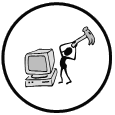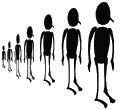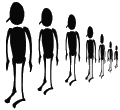
Understanding policy contexts


 |
Actor Analysis Understanding policy contexts |
  |
|
Ring QuestA brief history of Ring QuestRing Quest is a product of nostalgia. It is a Windows remake of the adventure game that I made on my first computer (a SHARP MZ80B) in 1983-1984, inspired by the HOBBIT game that Steve Richardson wrote in BASIC on the PDP-11/70 at Dickinson College. Late 2006, I ventured across the website www.sharpmz.org. This immediately brought me back to 1982 when, as a student of computer science in Leiden, I bought a SHARP MZ-80B, a sleek-looking Z80 based machine. Although within a year outdated by the advent of the IBM PC, my first personal programmable machine brought me a lot of joy, mainly because it allowed me to pursue a hobby I got addicted to a year earlier: writing computer games. I spent the academic year 1980-1981 at Dickinson College in Carlisle, PA. Enrolled as a foreign student majoring in chemistry, it was by accident that I "discovered" the university's computer: a PDP-11/70 running under the RSTS/E operating system. By consequence, BASIC was my first programming language. The computer's games directory featured a program called HOBBIT, and as I have been a Tolkien fan ever since my 12th birthday, this immediately caught my attention. Indeed, the game was a The Lord of the Rings variation on the then very popular game ADVENTURE. I was greatly inspired by HOBBIT, as it's author, Steve Richardson (in 1981 a junior at Dickinson) had taken such liberties with the story of Frodo's quest that I felt that a more faithful interpretation was desperately needed. With my at that time rather limited skill I programmed my own game, which I quite originally called HOBBIT. I did not do very well, as I quickly bumped into the limit of 16K memory for BASIC programs. Although practically a failure, my effort produced three great effects:
Indeed, having returned to The Netherlands and bought my SHARP MZ-80B, I started designing Ring Quest. I mapped out Middle-Earth on a 36x36 grid and conceived a plot that would remain as close as possible to Tolkien's tales and yet contain sufficient challenges for an adventure gamer. I kept Steve Richardson's original plot of the first person having to find all rings of power and cast them into Mt. Doom. More in particular, I copied the idea that you need a magical sword to destroy the Ringwraiths, but I got rid of Steve's Arthurian sidestep of having to throw a stone tablet into a lake, from which then a hand would rise to offer you the sword. From ADVENTURE I took the convention that only the first four letters of each word you type on the command line are interpreted, and sheer nostalgia (already then in 1982!) prompted me to put the classic ADVENTURE phrase "Initializing database - please stand by..." on the opening screen. To fit the game into the 64K of my MZ-80B, I programmed it using the KNIGHT assembler. I manually scrambled the hundreds of lines of descriptive text to reduce memory use as well as the chances of people finding out the plot by looking at the compiled code. Actually, the only a people who have ever played Ring Quest are my friends at Leiden university, who would invariably stay up until 3 A.M. to get to the end (where usually a bug would frustrate the final apotheosis). When I started my PhD research in Delft, I packed my MZ-80B in its box and stored it on the attic. The audio tapes that held my software I kept in a shoebox which (not quite unlike the One Ring of Power in its days) slipped into oblivion for ages (in this case, about 20 years). Early this year (2007), inspired by the SHARP MZ computer owners website, I got the idea to digitize the tapes and see if I could read them on my PC. The conversion to .WAV files with Audacity was easy and I learnt a lot about my old computer while writing a small program that converts the digitized waves on the tapes to a binary file. Having thus retrieved the assembler source code of Ring Quest, it took me a few weeks to translate the 2400 lines of compact code into about twice as many lines of Delphi Pascal. I tried to emulate the original look-and-feel by using a non-proportional font in green on black. Thus, the game you are about to play (I hope) is what you could call a "reinsilliconation" of the original version. I will admit that I fixed some bugs as I went along, and also that I added a command logging feature to allow players to recover quickly from an untimely demise, but other than that the game has not been altered. English grammar, style and spelling mistakes are "vintage 1982 Pieter Bots", although you may recognize some genuine JRRT sentences along the way. Click here to download the software (zipped). I hope you enjoy the game. For reactions and comments, please do not hesitate to mail me! |